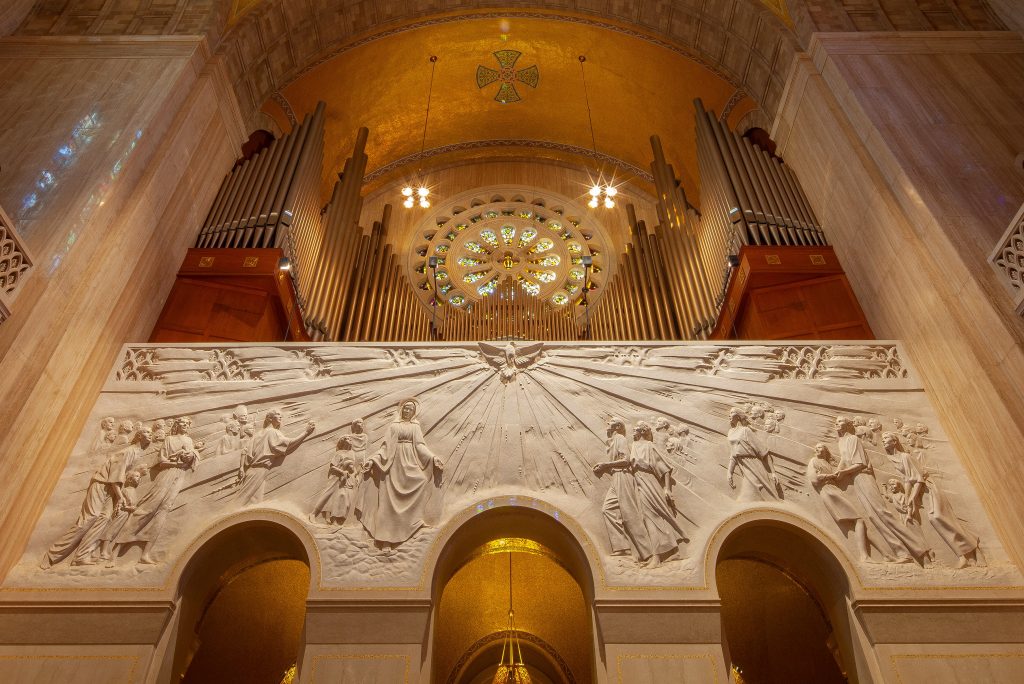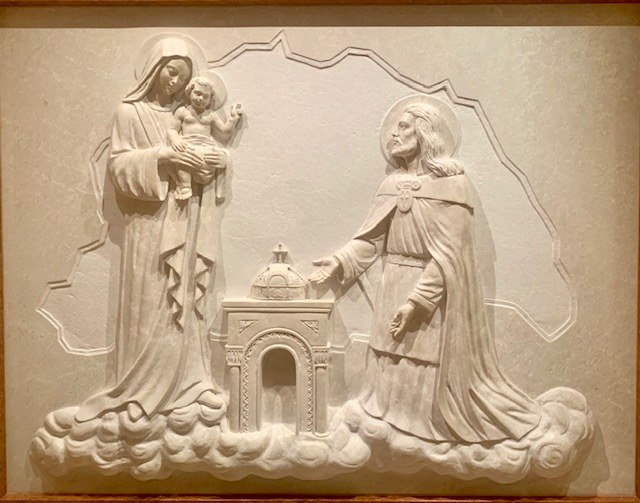
 You might be wondering: what exactly is relief sculpture? Relief sculpting is when a medium is molded against a flat surface, with a two or three-dimensional form emerging from the plane. Creating sculpture in relief, as opposed to a free-standing form like a statue, frees the artist from the constraints of weight and balance, and allows more expansive scenes to be portrayed using less material. It is well-suited for ornamentation purposes throughout sacred architecture, since sculptures can be carved directly into walls, facades, archways, and other building elements.
You might be wondering: what exactly is relief sculpture? Relief sculpting is when a medium is molded against a flat surface, with a two or three-dimensional form emerging from the plane. Creating sculpture in relief, as opposed to a free-standing form like a statue, frees the artist from the constraints of weight and balance, and allows more expansive scenes to be portrayed using less material. It is well-suited for ornamentation purposes throughout sacred architecture, since sculptures can be carved directly into walls, facades, archways, and other building elements.
Romanesque art heavily features figurative or stone sculpting, and following this tradition, the exterior of the Basilica contains heroic size figures of saints and finely sculpted tympana and archways. Tympana sculpted in relief ornament the interior east and west entrances and various niches in the nave and chancel areas.
Interested in exploring the breathtaking reliefs throughout the Basilica, but not sure where to start? We’ve selected some of the most distinctive relief sculptures of the Basilica and compiled them below.
 The Universal Call to Holiness
The Universal Call to Holiness
One of the largest relief sculptures in the world, The Universal Call to Holiness offers an awe-inspiring visualization of a profound spiritual reality: that the call to holiness extends to all peoples of faith in all times and places. Weighing over 37 tons and spanning 780 square feet, the relief portrays people of all ethnicities, ages, rank, and status being drawn to the Holy Spirit. The almost 50 figures depicted include the Virgin Mary, Pope John Paul II, Mother Teresa of Calcutta, and Cardinal Hickey.
You can read more about The Universal Call to Holiness and the incredible process used to create it in this post.
 The Holy Family
The Holy Family
The Holy Family Oratory features a Trani marble bas-relief of Jesus, Mary and Joseph. Fashioned by Theodore C. Barbarossa, it is the gift of Mrs. Carol Fox Kennedy, wife of National Shrine architect, Eugene F. Kennedy, Jr., Boston, Massachusetts (1961).
 Our Mother of Africa Chapel Relief
Our Mother of Africa Chapel Relief
In the Our Mother of Africa Chapel is a narrative relief of the African-American experience from slavery to emancipation. The sculpture culminates in a mother and father, freed from the bronze of the relief, stepping into the nave and lifting their arms to Christ on the cross. The chapel, a gift of the National Black Catholic Congress (NBCC), stands in remembrance of the painful history of slavery in the United States and the pillar of hope which Our Lady represented to many victims of this tragedy.
 Korean Tympana Reliefs
Korean Tympana Reliefs
In celebration of the centennial of Korean immigration to the United States in 2003, two Botticino marble tympana were blessed and dedicated on September 22, 2007: Our Lady of Korea at Cana (east; pictured) and Our Lady of the Korean Martyrs (west). The Korean artists are Song-Ja Rim and Eui-Soon Choi respectively, and the carving was executed in Pietrasanta, Italy (Rambusch Decorating Co.) The tympana are the gift of Korean-Americans.

Our Lady Star of the Sea Relief
Our Lady Star of the Sea, Ave Maris Stella is located to the right of the Korean tympanum. The sculpture portrays Mary calming the troubled sea with the North Star above her head, which is also a symbol for the Blessed Mother. Maris Stella or “Star of the Sea” is the name given to Our Lady by Saint Jerome, her title as the patroness of all who sail the seas. Saint Bonaventure once remarked that she “guides to a landfall in heaven those who navigate the sea of this world in the ship of innocence or penance.” This is the gift of the Apostleship of the Sea of the United States of America (AOS-USA), a professional association of Catholic seafarers.
 St. Stephen Chapel Reliefs
St. Stephen Chapel Reliefs
The St. Stephen Chapel features two Botticino marble reliefs depicting two significant events in the life of this saint who is patron of Hungary. The north wall relief shows the anointing of Stephen as King of Hungary by Pope Sylvester II in A.D. 1000. In this relief, he is pictured receiving two treasured symbols of the Hungarian nation: the cross and the crown. The piece is titled: The Baptism of Saint Stephen by Saint Adalbert and his Coronation as King of Hungary on Christmas Day, A.D. 1000. The relief on the south wall, pictured left, is titled Saint Stephen Giving His Crown to the Blessed Virgin Mary on the Day of His Death, August 15, 1038.
Source:
Basilica Guide and Tour Book, Dr. Geraldine Rohling

